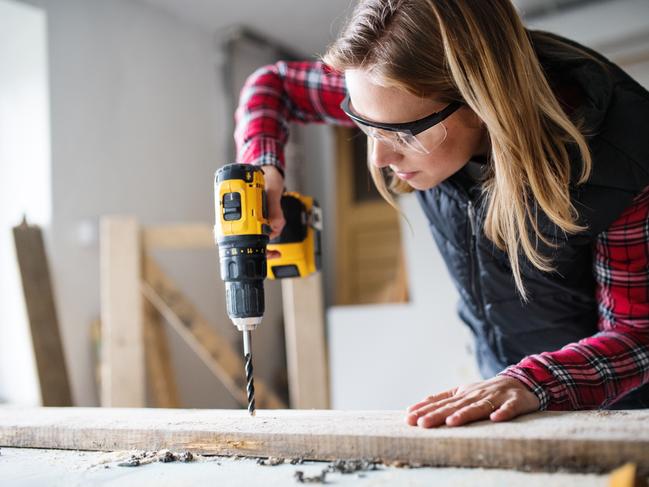DIY home projects: your home’s most important do-it-yourself item
No matter what you’re doing, or procrastinating about doing, around the house, you need one of these.
Property
Don't miss out on the headlines from Property. Followed categories will be added to My News.
The cordless power drill is one of the most versatile tools you’ll ever own.
Not just for professional carpenters or hardcore DIY-ers, the power drill is an indispensable tool for anyone looking at working on everything from minor to major home improvements and even arts and crafts.
Basically, you can equip them with needle-thin bits for drilling tiny holes to hang artwork or use big bits to drill through with larger holes.

The standard drill bits available at hardware stores work well with wood, steel and masonry. There are many different brands on the market, but they all function the same way.
National retailers Bunnings and Mitre 10 both offer workshops and YouTube videos on the basics of how to use a drill, with cordless drills the seemingly better option for freedom of movement.
Much like a sewing machine, where you decide which needle to use depending on the fabric thickness, the type of drill bit you select will depend on which material you intend to drill through.

Once you insert the drill bit firmly into the chuck (the clamp of the drill which holds the drill bit in place as it spins), you’re ready to start. Depending on the drill, you may be able to change the drill bit by hand, or you may need a chuck key, sold with the machine.
Carpenter and home renovator George Katsifaras says for starters, you must ensure the bit is straight and secure before you power away.
If you want to drill into a wall, make sure you use a stud finder to locate framing studs and to ensure you steer clear of live wires in the wall cavity before you drill.
“If you are drilling into small, loose pieces, don’t trust that you can just hold them together with one hand. Clamp them together because if the drill slips, you can really injure yourself,” says George.

“If this is your first time using a drill, do a practice run on spare material until you get comfortable with the tool.”
To begin with, he suggests drilling a small pilot hole. Then switch to a bigger drill bit if you need it to be bigger.
“This is much easier than having to patch up holes that are too big,” he says.
Once you’re confident in your ability to control the power drill, hold it steady and push it into the material you are drilling. If it takes more than light force to drill the hole, you are probably using the wrong bit.
DIY HOME PROJECTS: WHICH DRILL IS BEST?
The drill that’s best for you depends on how you’ll be using it.
Cordless drills are sized according to voltage, (12V, 14.4V, 18V and 20V), and drills with a higher voltage are more powerful. The bigger the voltage, the heavier and more expensive they are.
Also, these drills may also have features that you may never use as an amateur.
If you only anticipate doing light duty work, then think about a low-voltage drill.
Also, consider buying two batteries for your cordless drills, so when one runs out you can swap it over and keep working while the drained one charges.

Prior to selecting a drill bit, it is very important to determine the size and depth of the hole you are drilling.
● Wood drills bits: These usually have pointed tips and spurs on either side. These are the most commonly used bits, with titanium coated versions being the hardiest.
● Masonry drill bits: These bits have a sloping tip and can be used on stone and tile. It’s also often used to hang photos on the wall, breaking through tough surfaces such as brick.
● Metal drill bits: Often recognisable because of their wide-angled points, steel bits will drill through soft aluminium, though high-speed steel bits are required for anything tougher or thicker.
DIY PROJECTS SAFETY TIPS
● Wear safe clothing. Avoid anything baggy, or dangling jewellery that could catch in the drill as you lean over it.
● Wear safety goggles or glasses that cover the sides of your eyes, to protect them from flying debris or dust.
● If drilling regularly, wear ear protection, though most new cordless power drills on the market are quieter than older versions.
● If the project kicks up a lot of masonry dust, breathing protection is recommended. A dust mask is a good option in the short-term, but use a respiratory mask if you drill for long periods of time.
More Coverage
Originally published as DIY home projects: your home’s most important do-it-yourself item





